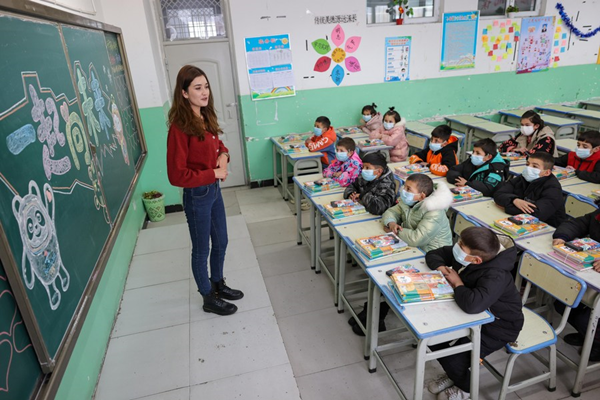Balanced Development of Education Benefits Students of All Ethnic Groups in Xinjiang
 |
| Students have class at a boarding primary school in the county seat of the Taxkorgan Tajik Autonomous County, northwest China's Xinjiang Uygur Autonomous Region, on Feb. 26, 2022. [Xinhua/Ding Lei] |
URUMQI, June 7 (Xinhua) — In a few sparsely populated pastoral areas of northwest China's Xinjiang Uygur Autonomous Region, classes were taught in tents and by teachers who would arrive on horseback, and school-age children could be spotted loitering around. But that is all history now, thanks to the region's continuous efforts in promoting balanced development of education.
Over the recent years, the right to education has been guaranteed for students of all ethnic groups in the region and the implementation of a slew of beneficiary policies has yielded fruitful results.
According to the regional department of education, the level of education in Xinjiang is at the highest and fastest-developing stage in history.
Statistics show that the number of students in schools at all levels and of all types increased from 4.9 million in 2015 to 6.5 million in 2020, among which ethnic minority students increased from 3.3 million to 4.8 million.
The coverage rate of government-funded and privately-run non-profit kindergartens, the completion rate of nine-year compulsory education and the gross enrollment rate of senior high schools in the region are all higher than the national average.
In recent years, Xinjiang has built, renovated or expanded more than 4,000 rural kindergartens, covering almost all administrative villages. The government has also provided subsidies to guarantee free preschool education for rural children.
"Children in the village can now enjoy the same pre-school education near home as children in cities. People are very satisfied with the government's beneficiary policies," said Xie Wenlu, principal of a kindergarten in Kashgar.
To promote even distribution of educational resources in southern Xinjiang, the region spent over 2.8 billion yuan (about 420.1 million U.S. dollars) to build nine educational compounds in Hotan, offering courses from kindergarten through high school.
To prevent students from dropping out of school due to financial difficulties, Xinjiang has also established an aid policy system for students from preschool to postgraduate education.
During the 13th Five-Year Plan period (2016-2020), Xinjiang allocated 31.2 billion yuan of financial aid to students at all levels and of various types, while in 2021, 8.3 billion yuan were allocated to the aid program, said the regional education department.
(Source: Xinhua)
Please understand that womenofchina.cn,a non-profit, information-communication website, cannot reach every writer before using articles and images. For copyright issues, please contact us by emailing: website@womenofchina.cn. The articles published and opinions expressed on this website represent the opinions of writers and are not necessarily shared by womenofchina.cn.






.jpg)

 WeChat
WeChat Weibo
Weibo 京公网安备 11010102004314号
京公网安备 11010102004314号